Traders, pilgrims – travelers, who utilized their legs and lungs through the mountain corridors of he Himalayas often tell tales of the mountains’ ‘natural order’, of the inevitable paths that lead and have led through the walls of stone. They defend the mountains and speak of an often brutal balance; there is and always has been a kind of fateful confidence that the ‘high’ lands are full of answers.
Far from simply being barriers and hulking uneven walls, mountains always provide for the intrepid, and the mountain borne peoples are nothing if not forceful in their own searches. Here the world of spirits takes a second row to the world of form. An exit, sometimes snowbound, is always to be found and in some typical wisdom of eastern Tibet “if one can get there, one can return from there”. All things and beings pay homage to the shapes, the oxygen starved air and of course to the winds.
As the east-west running Himalayas hit Yunnan and Sichuan on their far eastern frontier they meet ranges that run counter; north-south running ridges that cut and slice the land into valleys and rocky highlands.
West of my sparse ‘home’ in Zhongdian lies a range which has long remained present in the eye. Its understated curves run along our western flank. Heading north a line of dozens of kilometres reaches and curves towards the borders of Yunnan, Myanmar and Tibet proper.
December’s stolid greys have moved in and winds do what they do up here: they rule with patient, unrelenting power. They don’t so much punch as they do slowly ebb away at solid objects with steady force. Snow hasn’t yet thrown the full brunt of its challenging beauty into our little worlds of valleys and peaks. It remains in leftover patches. In the mountains it is the seasons that open and close the gateways in and out; it is the seasons that shut down sounds and senses and it is winter which brings all into solitary focus.
My own ritual at this time of year before the inevitable bit of time away is to do a last trek, an ascent somewhere ‘up’ to pay respects, sniff the incoming season of cold and reach in a bit further into areas that remain close but unexplored. It is also the ideal way to bid an old year farewell. Inevitably, these little jaunts are solo ‘projects’ which allow for a maximum degree of impetuous and selfish wanderlust. It is this inconspicuous line of stone to the west of Zhongdian that I see most days that finally draws me in for the December farewell.
Though my own legs have taken me into this ridge of stone in the past, I’ve long heard from traders of a path that leads west across to Tuo-ding – a valley town that doesn’t suffer the winter effects basking in the perpetual hot winds of the river valleys.
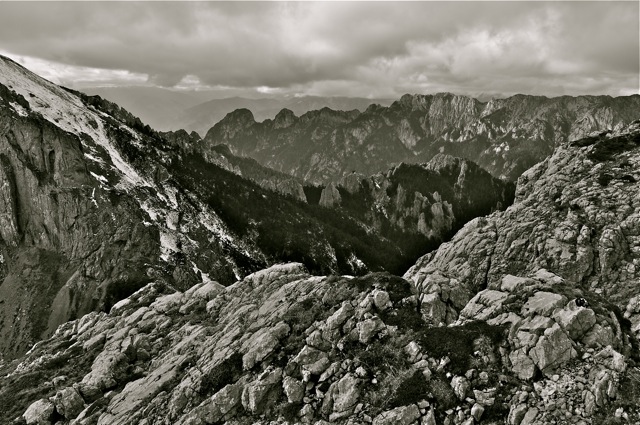
In Tibetan, 'nup' is west and it is to the west that my eyes and legs took the rest of me. Looking towards Myanmar and Tibet
Zhongdian’s ancient name of ‘Gyalthang’ makes reference to a ‘thang/tang’ (the suffix) or great grassland – in this case a 3300 metre grassland that splays outward in winter-dry topes and meandering waterways. The morning departure takes leave of this elevated flatland at close to 9 am as a morning light tries its luck to emerge.
West of Napa Lake a dozen short kilometres west of Zhongdian are logging paths veering up. It is one of these that I start upon. Most of the paths are wide with a deep trough or rut in the middle – logging routes where couples of yak will drag massive logs down from the heights in a wonderful ritual of plodding and power. Logs, sometimes 15 metres long will be used to build the traditional Tibetan structures of the region. These paths also lead into the mountains’ summer herding pastures where locals will spend the ‘hot’ season tending to their herds.

Looking south towards a new mountain range that these eyes have never seen...such are the heights - unveiling as they challenge.
Stone and its dull surface has a way of reflecting the sky, or simply sucking up all of the light. The clouds are being created above this line of stone as I reach up further. Zhongdian (its ‘purchased’ name Shangrila) sits in a dull sunlight behind and to the east of me but as I climb it as though I am climbing into an amphitheatre of mood bending purple-grey hues…and wind. The ‘Shangrila’ is long gone.
The element that the Tibetans know as “loong”, (wind) finds its setting of expression here amidst the heights shrieking over the lands. Crossing along a northern ledge directly above a pitch infested by scree, I can see that entire rock faces coloured by the white of past snows; it is a testament to these regions at four thousand metres how they change completely from season to season. Everything amid this lonely arid zone is touched and affected by everything else.
What I know of in these lands – portions and swathes of land previously encased in white – have unleashed their earth tones in wisps and swirls. The land is laid bare. What is seen as a simple line of hills – once penetrated – gives way to enormous gulleys, sheer drops and shimmering rows of peeks. Many times with limited sightlines I have seen only the immediate, a rock, a drift or a fuzzy funnel of light that hints at what is to come. On this day all is spread on a 360 degree platter of change creates an almost schizophrenic horizon.
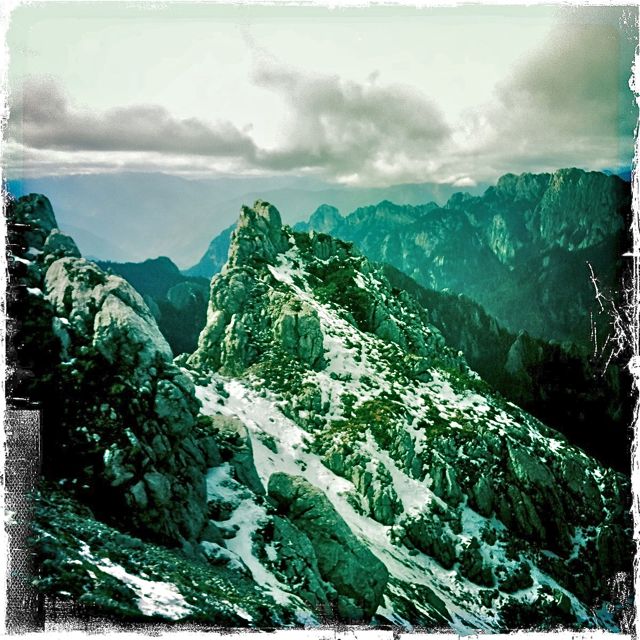
To get to the pass - or where I think the old pass is - I must first walk along ridges which have the winter's first touches upon them
Trees have long since disappeared as the alpine treeline is below somewhere; a a line I passed hours ago. Reference points are snow capped peaks, lonely crags and gnarled and indestructible rhododendron shrubs. They alone amongst the plant world seem at home and still even a little opulent. At this time of year in early December everything is shackled by the winds and oncoming winter but it is the time to savour the heights as things have been edited down to a simplified essence and a few raw constants. Nothing distracts from the cold, no nook can shelter the body. In small valley pockets bent wooden huts sit empty in wait for the summer, which surely must come but even they look barren and forgotten.
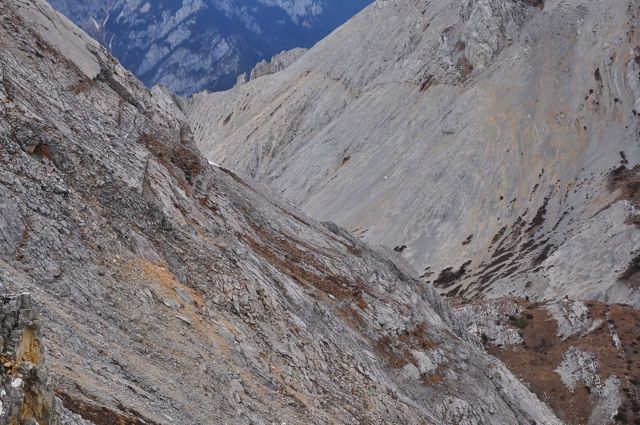
A spectacular valley that leads into another world is also and entrance...it is along valley floors and river beds that many of the ancient trade routes follow
Geography here on this day has become a series of abstracts with a soundtrack of buffeting wind. Heading further west a small curved valley of snow gives way to series of sculpted wedges – somehow it is a path – or more accurately a series of stops that seem linked.

Storm clouds gather from the south, or so it seems. They actually are driven in from the west and the Himalayas, whereby they rise with any significant incline and unleash their moods
Sharp valleys that fall off have the light blue sheen of old ice upon them; the sun’s rays unable to permeate for long enough to make an impression. Shoulders of rock hunch in ancient formations and I wonder if somehow all of this land around me is waiting for something. It is a paradise for the lonely and impact-starved. Turning the head can open up an entirely new vista of a landscape just seen. It is that, perhaps more than anything is the mountain’s great gift. Its ability to offer everything and nothing in a glance.
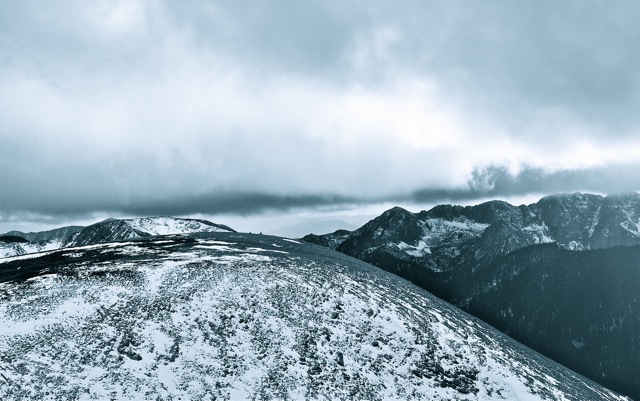
When the skies decide to open up, they can momentarily convince one of change...in this case the 'change' was but a bright moment
Up amid currents of air higher than I, a solitary vulture peers over a terrain that must seem insignificant. Carving the heights its wings need not move. Odd cairns of rock stand piled up as little testaments to the animist gods and to a time and people that took time.
A rounded hump appears ahead, dominating even the distant snowcaps that flutter in and our of site with passing clouds. This hump appears as an entire mountain of smooth rounded scree with touches of ice sitting upon its edges. Wedged in between the enormous round mound and a sharper set of peaks is a depression and in that depression is a path, which shoots downwards into an enormous valley. It is here that the villagers, traders and pilgrims from further west and from Gyalthang itself would cruise over the mountains into further valleys only to re-cross yet again. Here is the decline and the inevitable dip back into the populated valleys that I’ve long heard of.
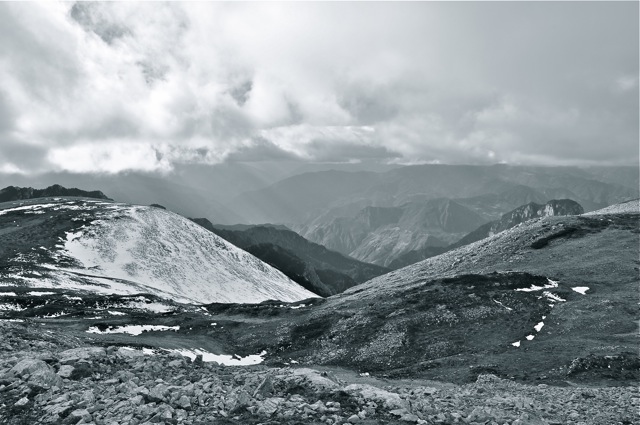
Finally the pass that old Norbu spoke of so many times a pass that led west into the valley towns. The route itself linked up one massive valley with the Zhongdian 'grasslands'
Winds here pick up their hum, gaining force with the open expanses before them. The wind sings of itself and its magnificence…it sings of the fact that up here it is content to compete with itself.
A mass bank of temperamental clouds sits just above, letting in bursts of cold light. It is this grand expanse of brittle and seething space with its lack of visible movement that I have come for. Seeing the old trade path that wanders down makes the journey that little bit more perfect – it is where an old trader, Norbu, said it would be (in typical local trader speak), “beyond the hills, beyond a tea break, before you go down”.
He failed to mention the wind…

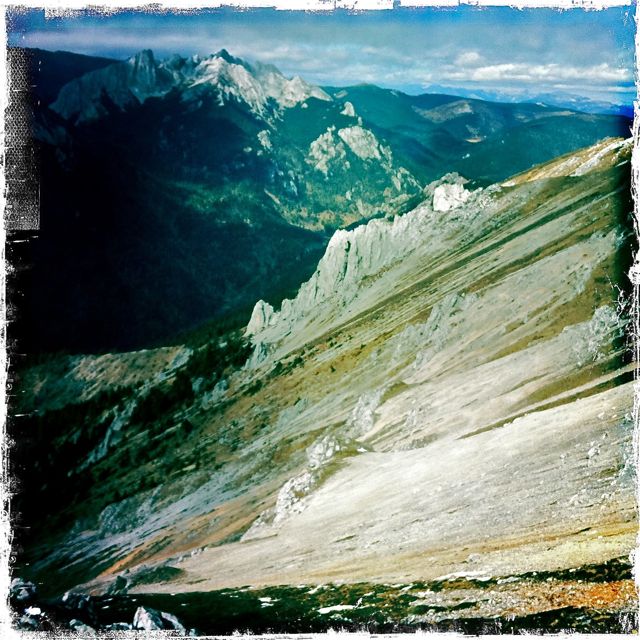
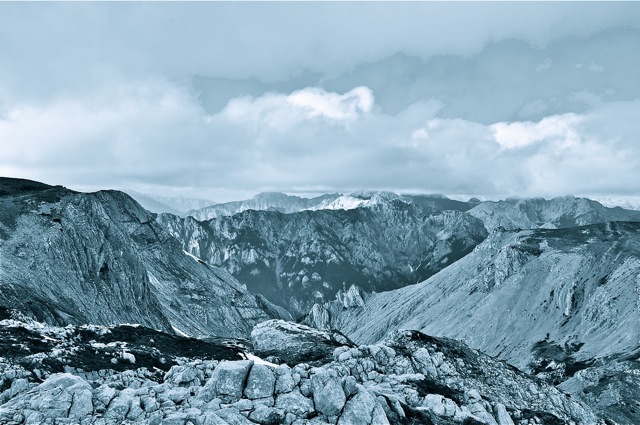
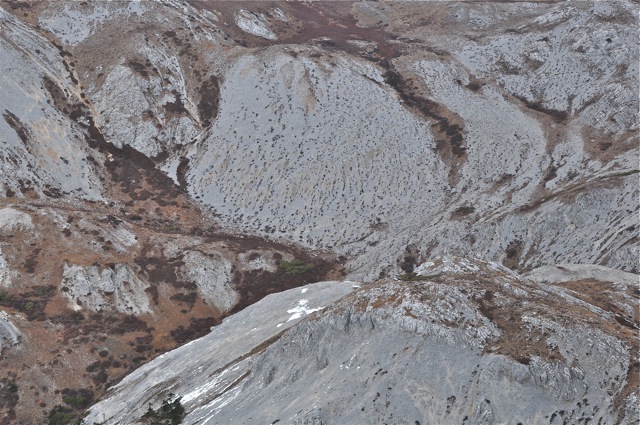



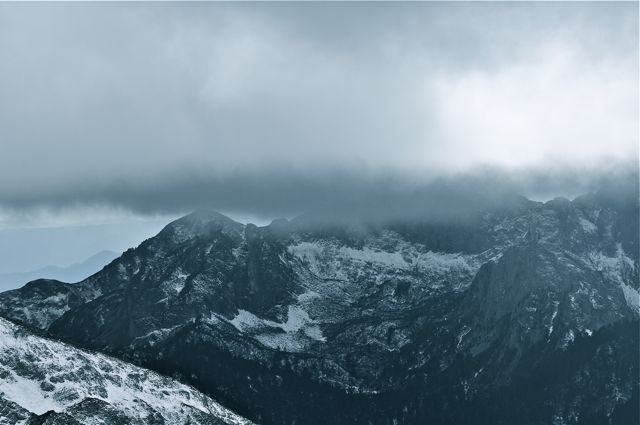
What a wonderful article – again!
Nice that you have joined along.
Jeff